BY MICHAEL J. BARAKEY and KEVIN SHEA
Following the 9/11 terrorist attacks and catastrophic weather events, the responsibility for ensuring that well-coordinated, well-trained, and adequately equipped responders are available for large-scale disasters has fallen to state government, not just the local municipality or the federal government. These events also demonstrate that disasters have no boundaries and can have an impact on a region and several states simultaneously. The State of Indiana has taken a proactive approach to state-level emergency preparedness and response in anticipation of natural disasters like tornadoes, floods, and winter storms, which have historically impacted counties in the state. An example of this was the severe weather and flooding that occurred June 6, 2008. Thunderstorms produced heavy rain across portions of Central Indiana, dumping nearly 11 inches of rain in some areas of the state overnight. These rains led to river flooding during the following week as the water saturated rivers and creeks, causing record floods.
The community of Columbus, Indiana, was devastated. It became isolated once roads into the city were flooded. With many structures in the city flooded, including the first floor and basement of the Columbus Regional Hospital, responders were forced to evacuate patients from the hospital and search the community and businesses for missing people. There were three documented fatalities and five injuries. Reports after the event concluded that thousands of citizens were evacuated and many water rescues were made during the flooding. The National Guard, Red Cross, Indiana State Police, and U.S. Marines were mobilized to assist the flood victims.1
This large-scale incident required a massive mutual-aid response and the activation of state and federal resources. A disaster that affects multiple counties and jurisdictions necessitates a coordinated, effective emergency response. Multiple local, state, and federal agencies, departments, and governmental entities must respond and be coordinated to meet the immediate needs of the community. To assist local emergency responders and government officials, as well as to improve overall coordination, Indiana developed the District Planning Council (DPC) and District Task Force (DTF) Program.
The DPC divided the state into 10 Homeland Security districts. The council encouraged collaboration and teamwork among the teams so that the state could plan, organize, and manage critical emergency response activities on a regional basis. This structure brought multiple jurisdictions, disciplines, and agencies together into a formal organization (Figure 1).
| Figure 1. IDHS District Task Forces |
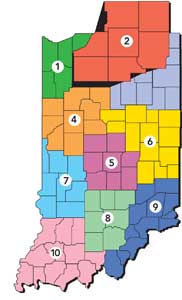 |
SCOPE OF EXERCISE
To exercise these districts in the response phase of a natural disaster, the Indiana Department of Homeland Security (IDHS) conducted several full-scale exercises over the past several years. Most recently, IDHS completed a full-scale exercise at the Muscatatuck (IN) Urban Training Center (MUTC) September 22-26, 2013. This exercise continued to test and evaluate district task forces’ abilities to respond to and mitigate a disaster caused by catastrophic weather. The exercise was designed as a continuous exercise, incorporating multiple operational periods over multiple days, eliminating the possibility of “Groundhog Day operations” (when the responders complete the same scenarios each day, leading to information sharing and predictable results).
The exercise focused on a natural-hazard event. In accordance with guidance from the IDHS, the scenarios provided realistic injects (inserted conditions) that stressed responders. The core capabilities exercised were infrastructure systems, mass search and rescue operations, on-scene security and protection, communication, coordination, public health and medical services, public information, and warning.
The exercise simulated severe weather sweeping through a town in Indiana. The severe weather spawned an EF3 tornado, producing damaging winds and heavy rainfall that resulted in localized flooding. The MUTC provided responders with a realistic disaster setting that included flooded homes, debris-littered streets, compromised buildings, and role players in moulage to simulate “survivors” in need of medical attention.
IDHS districts 1, 3, 4, 8, and 9 participated in the exercise. Each district response task force incorporates members from firefighting, law enforcement, emergency medical, health, and public works. The task forces provide search and rescue, technical rescue, swift water and flood responses, hazmat, mass casualty, incident management training, riot control and force protection, and communications.
In addition to the traditional police, fire, and emergency medical services (EMS) agencies, the following agencies and organizations took part in the exercise: the Indiana National Guard, the Indiana Building Emergency Assessment and Monitoring (I-BEAM) Team, the Indiana Department of Transportation, the Indiana State Board of Animal Health, the Indiana State Department of Health, the Indiana State Police, and Nature’s Way (animal emergency rescue).
The exercise created a realistic training environment that exercised and simulated responses and actions of the local and state police; local fire responders; EMS; canine search and rescue; structural collapse of light and engineered buildings; trapped victims; the all-hazards incident management team; hospitals; logistics; the emergency operations center; communications; IBEAM (engineers and building stability assessments); debris removal; public information; town, county, and state official injections; animal response and rescue; and decontamination (equine and canine).
The disaster provided active fire incidents, tornado debris littered throughout the city, damaged residential and commercial buildings, damaged utilities and roads, water rescue operations and evacuations, stressors to include heat and fatigue issues resulting from long operational periods, and actors playing injured patients throughout the site.
LOCATION
The MUTC is in Jennings County, Indiana. It is a self-contained community that once was home to the Muscatatuck State Developmental Center. The 1,000-acre site was turned over to the Indiana National Guard in 2005 and has evolved into a fully functional disaster city and community serving local first responders, state and federal urban search and rescue teams, police and SWAT teams, hazardous materials teams, technical rescue teams, special operations military units, and many other organizations that need to train in a contemporary urban training environment (Figure 2).
| Figure 2. Map of MUTC Grounds |
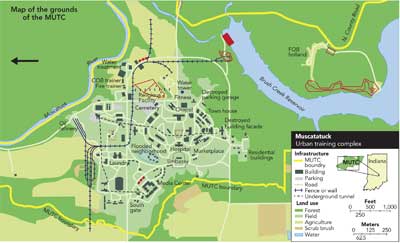 |
The MUTC has a 180-acre reservoir, urban infrastructure consisting of 68 major buildings including a school, a hospital, dormitories, light industrial structures, single-family type dwellings, a dining facility and administrative buildings, and an extensive underground utility tunnel system.2
EXERCISE DESIGN
The exercise design staff of the IDHS was responsible for the overall development and command and control of the exercise. It contracted experienced and specialized subject matter experts to facilitate rescue-based scenarios to include technical rescue, urban search and rescue (heavy lifting and moving, breaking and breaching, and shoring), water response and rescue, canine search using live victims and human remains, and high- and low-angle rope rescue work. The deliverable included the development of multiple scenarios involving search and rescue, technical rescue, swift water and flood response, hazmat, mass casualty, incident command, riot control, force protection, and communications.
Each scenario was designed to facilitate 12-hour operation periods with a contingency plan for additional scenarios to extend operations if needed. Staffing and materials were brought on site to MUTC where all props needed to deliver quality scenarios with structural collapse, water rescue, confined space, and wide area search and animal rescue sites prior to the start of the exercise were designed, developed, and prepared. Staffing was provided to facilitate the management of site logistics, ensure scenarios were reset, and other associated activities required during the exercise period. This included complete setup, tear down, and maintenance of the facilities used on site to sustain the exercise and then return the site to the conditions specified by the MUTC staff.
With an exercise of this magnitude, specialized and equipped rescuers were tasked with overall site scenario supervision during exercising and responded to and coordinated with exercise command (SIMCELL) to ensure continuous operation of rescue scenarios. This was accomplished by integrating experienced command staff personnel at the exercise command post during operational periods to act as a liaison with the SIMCELL. The command staff was required to relay logistical needs/requests through the SIMCELL Logistics Section chief, attend all planning conferences related to the exercise including an initial planning conference, a midterm planning conference, a final planning conference, a master scenario events list sync conference, and an after-action conference. Homeland Security Exercise and Evaluation Plan-compliant evaluations were used to assess the responders’ skill sets. The contracted rescuers facilitated the hot wash session with exercise participants and provided a comprehensive after-action report to the IDHS within 30 days of the conclusion of the exercise.
INDIVIDUAL SCENARIOS
Search and Rescue
• Light construction search and rescue. The severe weather and tornado damaged or destroyed several homes and a trailer park. Several homes had partially collapsed, trapping residents inside. Disaster response teams (DRTs) had to work to remove the trapped persons and had to assess the buildings for structural stability and use shoring techniques before entering (photo 1). This scenario, which occurred during an entire operational period, was controlled and evaluated. Canines were deployed to the area in advance of search and rescue task forces and integrated with the rescue teams in that area to locate victims. Once search and rescue operations were completed, structural engineers from the DRT IBEAM inspected the buildings. Law enforcement and EMS units were requested through the established command system (the district’s incident management team) to provide force protection or patient transport once the patients were packaged and removed.
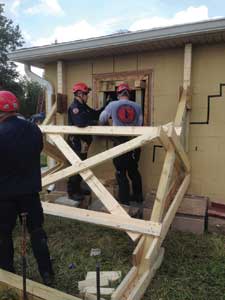 |
| (1) Members of the IDHS District 4 Task Force shoring a damaged house. (Photos by authors.) |
• Commercial structural collapse. For this exercise, the commercial district was the hardest hit by the tornado. Several office and commercial buildings sustained catastrophic damage. Live and manikin victims were trapped and pinned by debris, requiring advanced breaking and breaching techniques, the use of search cameras, and the lifting and moving of heavy objects to assess and package victims. This scenario took an entire operational period and taxed the DRTs. They had limited personnel, but this is to be expected within the first 12 to 24 hours of an operation. The commercial district consisted of concrete and steel construction with lean-to and pancake collapses. Law enforcement and EMS units were requested through command as necessary. Operations in this area also included rope rescue injects, as accessibility to victims was often vertical. Canines were deployed in coordination of the rescue teams to perform searches of the devastated area (photo 2). Controllers placed live victims and human remains to test and evaluate the canines.
 |
| (2) A canine search underway at the parking garage collapse. |
• Flooding. The flooded community challenged rescuers as actors were deployed around the flooded area, on rooftops, inside buildings, and floating in the water. The DRTs had to assess the area from the flooded banks and work within the command structure to request water assets to rescue the stranded residents. The scenario allowed for rescuers to conclude that the water came up so quickly that many of the residents were forced to take refuge in their attic spaces. Once at the underwater buildings, the rescuers had to search the residences and had to rescue victims or confirm that the residence was clear (photo 3). Stranded animals in the structures and on rooftops were injected into this scenario. This forced responders to perform animal rescues and deliver stranded animals to the bank where they were decontaminated using appropriate animal decontamination techniques. Appropriate search markings were required. The scenario was challenging to the responders, as using water assets to package and remove patients was difficult.
 |
| (3) A water rescue team accessing a window in the flooded community. |
• Water rescues. The vacationers-stranded-on-the-lake scenario allowed water rescue teams to evacuate a nature/camping area by a municipal reservoir. Vacationers were stranded without cellular phone communications after the intense storm came through the popular vacation area. Once the water rescue assets arrived, they had to find the base camp and start a systematic search of the bank. When the team made it to the camp, the DRT found a large group of people with various injuries; some were nonambulatory. The evacuees had to be taken by boat to the evacuation point.
Canine Search
Integration of canines is essential when search and rescue teams are limited and large areas need to be searched following a large disaster. The severe weather caused an old building to collapse, trapping victims in void spaces. The exact number of occupants was not known, but information from the locals indicated they had seen several people coming from the structure. Canines were deployed to the collapsed building to search the pile (photo 4). Live victims and human remains were placed to distract the canines.
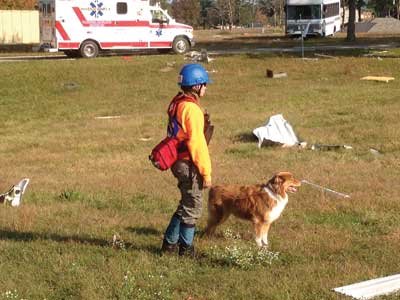 |
| (4) The Division 4 canine search team working a housing district devastated by the simulated EF3 tornado. |
Rope Rescue Events
During search and rescue efforts in the commercial area, rescue crews found a person trapped in an elevator shaft. This rescue challenged the DRT, as the only access to the patient was from the top of the elevator shaft. Rescue crews had to rappel down the shaft, lift a concrete slab off the trapped manikin, package the injured, and make a haul once the patient was lashed in the basket. High-angle rope rescue techniques were used in this rescue (photo 5).
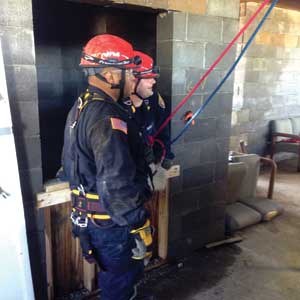 |
| (5) Members of the District 8 search and rescue team make entry into an elevator shaft for victim rescue. |
Water Tower Rescue
Just after the storm was over, crews were inspecting the city water tower to determine if it had sustained any damage. During the inspection, one of the workers slipped and fell. The worker’s fall suppression equipment deployed, suspending him under the water tower. The DRT sent a messenger line over an overhead anchoring point. Once they established a suitable anchor, lowering system, and belay, a rescuer was hauled to the suspended victim and transferred to the rescuer (photo 6). The victim and the rescuer were lowered to the ground.
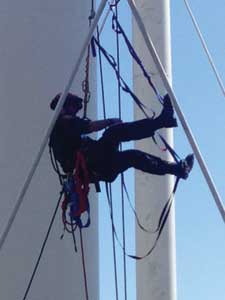 |
| (6) A member of the District 8 technical rescue team ascends a rope to rescue a worker suspended from the water tower. |
LESSONS LEARNED
- Eliminate the responders’ desire to freelance. Have contingency plans in place to corral exercise participants who are working outside their comfort level. For example, law enforcement officers responding as initial responders to a commercial building were often found on top of rubble piles and inside void spaces. This freelancing led to initial responders becoming “victims” and unable to report back damage assessments. Their mission was a windshield survey and to report back to the Operations Section chief, but these initial responders could not engage. They had to be corralled and told to resist the urge to get out and make contact with the injured and needy.
- Know the experience and capabilities of the responders. Just because the rescue teams are advertised and typed at a certain level [(i.e., Type III incident management team (IMT)] does not mean the responders are capable of delivering the advertised level of service or work. Have contingencies in case the team or task force cannot work to the desired scenario. Know the capability of the task forces and teams with respect to equipment and personnel brought to the exercise. Not all teams or responders are equipped or have the skills/training to execute the scenarios. Have logistical contingencies if the teams cannot provide appropriate equipment for the injects or scenarios.
- Not all responders have the same training, yet as a member of a task force, they are placed in positions outside their normal training or experience. As a result, in disasters, first-arriving personnel have gaps in knowledge and training and perform on instinct and feelings. These responders do not know how to read buildings and do not understand the hazards associated with a disaster. These responders need to be provided with awareness-level training.
- During a disaster, responders are placed in situations outside their level of training or experience. Normal expectations of having responders’ skills levels match the scenario presented may not be met with limited resources spread around a countywide disaster. Awareness/operations/technician-level training is desired but is not essential to operating in a disaster.
- State and local responders will be the first to arrive to any disaster. The next tier of responders needs to be requested early, using the appropriate declarations, to get federal and other state assets mobilized and responding.
- The IMT sets the tone for the branch directors, divisions, and group supervisors. Clear objectives and expectations must be disseminated, and proper forms and incident action plans are essential for the sharing of accurate information. In major emergencies and disasters, the media will be reporting on the incident, and the IMT will gain intelligence from these media reports. Local incident commanders and officials must use the media to their advantage to gain intelligence on the storm’s path and destruction. Have the planning cell review and document the media’s coverage and report/share intelligence with the IMTs and the incident commander.
Endnotes
1. http://pubs.usgs.gov/of/2008/1322/pdf/ofr2008-1322.pdf.
MICHAEL J. BARAKEY is a district chief with the Virginia Beach (VA) Fire Department, where he is assigned to Personnel and Development. Previously, he was assigned to Operations and Training. He is a hazmat specialist, an instructor III, a nationally registered paramedic, and a neonatal/pediatric critical care paramedic for the Children’s Hospital of the King’s Daughters in Norfolk, Virginia. Barakey is a plans team manager for the VA-TF2 US&R team and has a master of public administration degree from Old Dominion University in Norfolk, Virginia. He is an FDIC classroom instructor.
KEVIN SHEA, a 35-plus-year veteran of the fire service, is a retired lieutenant from the Fire Department of New York. He is the author of the FireLife monthly video column “Off Duty with Kevin Shea” covering his adventures as he hunts and fishes across the North American continent. He has taught for New York State, Suffolk County, New York City, and private companies. He is a partner at Spec Rescue International.
Fire Engineering Archives

